
Lebanon, officially the Republic of Lebanon, is a country in West Asia. It is bordered by Syria to the north and east, by Israel to the south, and by the Mediterranean Sea to the west; Cyprus lies a short distance away from the country's coastline. Lebanon's location at the crossroads of the Mediterranean Basin and the Arabian hinterlands has contributed to the country's rich history and shaped a unique cultural identity denoted by religious diversity. Located in the Levant region of the Eastern Mediterranean, the country has a population of more than five million people and covers an area of 10,452 square kilometres (4,036 sq mi). Lebanon's capital and largest city is Beirut, followed by Tripoli and Jounieh. While Arabic is the official language, French is also recognized in a formal capacity; Lebanese Arabic is the country's vernacular, though French and English play a relatively significant role in everyday life, with Modern Standard Arabic being limited to news and government matters.

The Latin Church of the Catholic Church has several dispersed populations of members in the Middle East, notably in Turkey and the Levant. Latin Catholics employ the Latin liturgical rites, in contrast to Eastern Catholics who fall under their respective church's patriarchs and employ distinct Eastern Catholic liturgies, while being in full communion with the worldwide Catholic Church. Latin Catholics in the Middle East are often of European descent, particularly from the medieval Crusader era and later the 20th-century colonial period.
Sui iuris, also spelled sui juris, is a Latin phrase that literally means "of one's own right". It is used in both the Catholic Church's canon law and secular law. The term church sui iuris is used in the Catholic Code of Canons of the Eastern Churches (CCEO) to denote the autonomous churches in Catholic communion. The Catholic Church consists of 24 churches, including the Latin Church and 23 Eastern Catholic churches.

The Lebanon national football team, controlled by the Lebanese Football Association (LFA), have represented Lebanon in association football since their inception in 1933. The squad is governed by the Asian Football Confederation (AFC) continentally, and FIFA worldwide. While Lebanon have yet to qualify for the FIFA World Cup, they have qualified three times to the AFC Asian Cup: they first participated in 2000, when they hosted the event. Lebanon's main venue is the Camille Chamoun Sports City Stadium in Beirut; however they also play in other locations such as the Saida Municipal Stadium in Sidon.

Lebanese Arabic, or simply Lebanese, is a variety of North Levantine Arabic, indigenous to and primarily spoken in Lebanon, with significant linguistic influences borrowed from other Middle Eastern and European languages and is in some ways unique from other varieties of Arabic. Due to multilingualism and pervasive diglossia among Lebanese people, it is not uncommon for Lebanese people to code-switch between or mix Lebanese Arabic, French, and English in their daily speech. It is also spoken among the Lebanese diaspora.
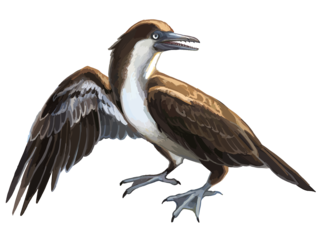
Yanornis is an extinct genus of fish-eating Early Cretaceous birds. Two species have been described, both from Liaoning province, China: Yanornis martini, based on several fossils found in the 120-million-year-old Jiufotang Formation at Chaoyang, and Yanornis guozhangi, from the 124-million-year-old Yixian Formation.

The Catholic Church in Lebanon is part of the worldwide Catholic Church under the spiritual leadership of the Pope in Rome.

Fenethylline is a codrug of amphetamine and theophylline and a prodrug to both. It is also spelled phenethylline and fenetylline (INN); other names for it are amphetaminoethyltheophylline and amfetyline. The drug was marketed for use as a psychostimulant under the brand names Captagon, Biocapton, and Fitton. It is now illegal in most countries and is produced primarily for illicit use. Syria is considered to be the world's largest producer of the drug, accounting for about 80% of the global supply.

Yungavolucris is a genus of enantiornithean birds. It contains the single species Yungavolucris brevipedalis, which lived in the Late Cretaceous. The fossil bones were found in the Lecho Formation at estancia El Brete, Argentina."Yungavolucris brevipedalis" means "Short-footed Yungas bird". The generic name, Yungavolucris is after the Yungas region + the Latin volucris, which translates to "bird". The specific name brevipedalis is from the Latin brevis, which means "short", + pedalis, from the Latin pes, meaning "foot".
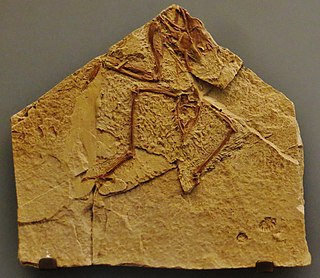
Concornis is a genus of enantiornithean birds which lived during the early Cretaceous period, in the late Barremian age about 125 million years ago. Its remains are known from the Calizas de La Huérgina Formation at Las Hoyas, Cuenca province, Spain. The single known species, Concornis lacustris, was described from the remains of one fairly complete individual skeleton.

Italy–Lebanon relations are relations between Italy and Lebanon. Both countries are members of the Union for the Mediterranean. Italy consideres Hezbollah, a major force in Lebanon a terrorist organisation.

Avisauridae is a family of extinct enantiornithine dinosaurs from the Cretaceous period, distinguished by several features of their ankle bones. Depending on the definition used, Avisauridae is either a broad and widespread group of advanced enantiornithines, or a small family within that group, restricted to species from the Late Cretaceous of North and South America.
There is a small Italian community in Lebanon consisting mainly of Lebanese citizens of Italian heritage as well with expatriates and migrants from Italy who reside in Lebanon. It is a community with a history that goes back to Roman times.
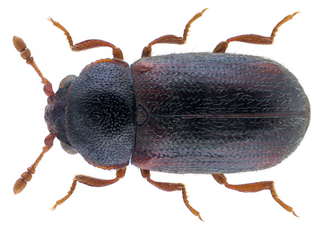
Sphindidae is a family of beetles, in the suborder Polyphaga. They are called slime mold beetles due to their exclusive feeding on slime molds during adult and larval stages, other aspects of their life history are obscure. Palaeontological discoveries since 2015 have added to the geologic history of Sphindidae, including the discovery of Libanopsis, placed in the extinct subfamily Libanopsinae.
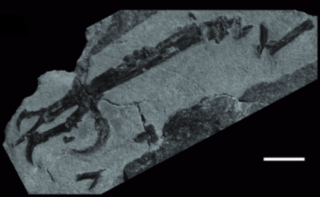
Intiornis is an extinct genus of avisaurid enantiornithean birds which existed in what is now North-West Argentina during the late Cretaceous period.
The Sannine Formation, also called the Sannine Limestone, is a Cretaceous geologic formation in Lebanon.

Rhinochelys is an extinct genus of sea turtles belonging to the family Protostegidae.
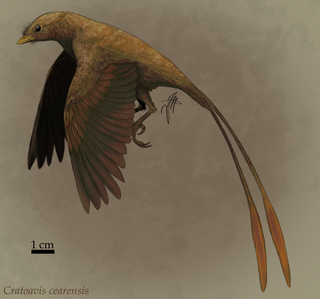
Cratoavis is a genus of enantiornithines. The type and only currently described species is C. cearensis, from the Early Cretaceous of Araripe Basin, Ceará, Brazil. The fossil, an articulated skeleton with feathers attached to the wings and surrounding the body, extends considerably the temporal record of the group at South America.

Lebanon have participated three times at the AFC Asian Cup. Their first participation came in 2000, when they hosted the tournament after healing from the Lebanese Civil War. The 2019 edition was Lebanon's first participation via qualification.
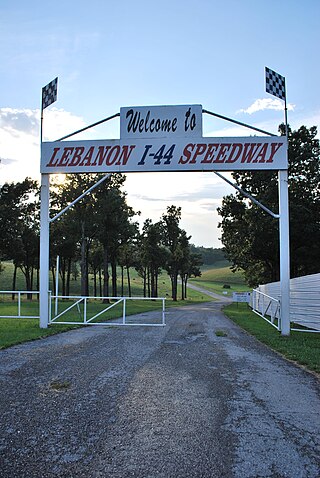
Lebanon I-44 Speedway is a multi-purpose speedway located in the Ozark Highlands, just off Interstate 44 outside Lebanon, Missouri, United States.


















